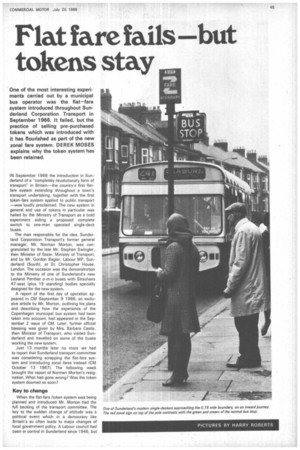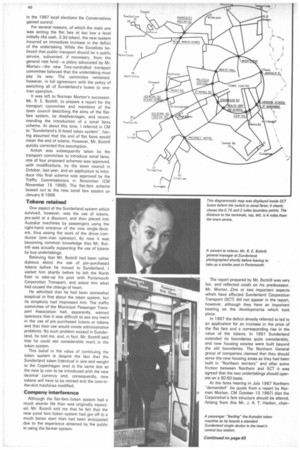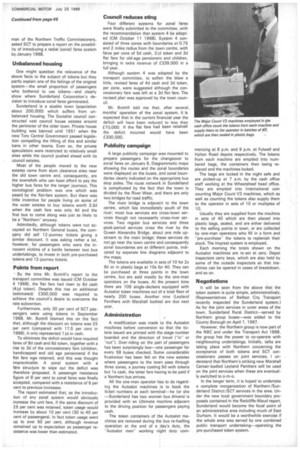Flat fare fails but tokens stay
Page 47

Page 48

Page 51

If you've noticed an error in this article please click here to report it so we can fix it.
One of the most interesting experiments carried out by a municipal bus operator was the flat—fare system introduced throughout Sunderland Corporation Transport in September 1966. It failed, but the practice of selling pre-purchased tokens which was introduced with it has flourished as part of the new zonal fare system. DEREK MOSES explains why the token system has been retained.
IN September 1966 the introduction in Sunderland of a "completely,revolutionary form of transport" in Britain—the country's first flat fare system extending throughout a town's transport undertaking, together with the first token-fare system applied to public transport —was loudly proclaimed. The new system in general and use of tokens in particular was hailed by the Ministry of Transport as a bold experiment aiding a proposed complete switch to one-man operated single-deck buses.
The man responsible for the idea, Sunderland Corporation Transport's former general manager, Mr. Norman Morton, was congratulated by the late Mr. Stephen Swingler, then Minister of State. Ministry of Transport, and by Mr. Gordon Bagier, Labour MP, Sunderland {South), at St. Christopher House, London. The occasion was the demonstration to the Ministry of one of Sunderland's new Leyland Panther o-m-o buses with Strachans 47-seat {plus 19 standing) bodies specially designed for the new system.
A report of the first day of operation appeared in CM September 9 1966; an exclusive article by Mr. Morton, outlining his plans and describing how the experience of the Copenhagen municipal bus system had been taken into account, had appeared in the September 2 issue of CM. Later, further official blessing was given by Mrs. Barbara Castle, then Minister of Transport, who visited Sunderland and travelled on some of the buses working the new system.
Just 13 months later no more we had to report that Sunderland transport committee was considering scrapping the flat-fare system and introducing zonal fares instead {CM October 13 1967). The following week brought the report of Norman Morton's resignation. What had gone wrong? Was the token system doomed so soon?
Key to change
When the flat-fare /token system was being planned and introduced Mr. Morton had the full backing of the transport committee. The key to the sudden change of attitude was a political event which in a democracy like Britain's so often leads to major changes of local government policy. A Labour council had been in control in Sunderland since 1946, but in the 1967 local elections the Conservatives gained control.
For several reasons, of which the main one was setting the flat fare at too low a level initially (4d cash, 3.3d token), the new system incurred an immediate increase in the deficit of the undertaking. While the Socialists believed that public transport should be a public service, subvented, if necessary, from the general rate fund—a policy advocated by Mr. Morton—the new Tory-controlled transport committee believed that the undertaking must pay its way. The committee remained. however, in full agreement with the policy of switching all of Sunderland's buses to oneman operation.
It was left to Norman Morton's successor, Mr. IR. E. Bottrill, to prepare a report for the transport committee and members of the town council describing the aims of the flat fare system, its disadvantages, and recommending the introduction of a zonal fares scheme. At about this time, I referred in CM to -Sunderland's ill-fated token system", having assumed that the end of flat fares would mean the end of tokens. However, Mr. Bottrill quickly corrected this assumption.
Action was subsequently taken by the transport committee to introduce zonal fares, one of four proposed schemes was approved. with modifications, by the town council in October, last year, and an application to introduce this final scheme was approved by the Traffic Commissioners in November (CM November 15 1968). The flat-fare scheme bowed out to the new zonal fare system on January 6 1969.
Tokens retained
One aspect of the Sunderland system which survived, however, was the use of tokens, pre-sold at a discount, and then placed into Autoslot machines by passengers using the right-hand entrance of the new single-deckers, thus easing the work of the driver /conductor (one-roan operator). By now it was becoming common knowledge that Mr. Bottrill was actually supporting the use of tokens by bus undertakings.
Believing that Mr. Bottrill had been rather dubious about the use of pre-purchased tokens before he moved to Sunderland, I visited him shortly before he left the North East to take-up his post with Portsmouth Corporation Transport, and asked him what had caused the change of heart.
He admitted that he had been somewhat sceptical at first about the token system, but its simplicity had impressed him. The traffic committee of the Municipal Passenger Transport Association had, apparently, warned operators that it was difficult to see any merit in the use of pre-purchased tickets or tokens and that their use would create administrative problems. No such problem existed in Sunderland, he told me, and, in fact, Mr. Bottrill said that he could see considerable merit in the token system.
This belief in the value of continuing the token system is despite the fact that the Sunderland token (identical in size and weight to the Copenhagen one) is the same size as the new lp coin to be introduced with the new decimal currency and, consequently, new tokens will have to be minted and the coin-inthe-slot machines modified.
Company interference
Although the flat-fare /token system had a much shorter life than was originally expect ed, Mr. Bottrill told me that he felt that the new zonal fare /token system had got off to a much better start than had been anticipated due to the experience obtained by the public in using the former system. The report prepared by Mr. Bottrill was very fair, and reflected credit on his predecessor, Mr. Morton. One or two important aspects which have affected Sunderland Corporation Transport (SCT) did not appear in the report, however, although they have an important bearing on the developments which took place.
In 1967 the deficit already referred to led to an application for an increase in the price of the flat fare and a corresponding rise in the value of the tokens. In 1951 Sunderland extended its boundaries quite considerably, and new housing estates were built beyond the old boundaries. The Northern General group of companies claimed that they should serve the new housing areas as they had been built in -Northern territory" and after some friction between Northern and SCT it was agreed that the two undertakings should operate on a 50:50 basis.
At the fares hearing in July 1967 Northern "demanded" (to quote from a report by Norman Morton, CM October 13 1967) that the Corporation's fare structure should be altered. Arising from this Mr. J. A. T. Hanlon, chair man of the Northern Traffic Commissioners, asked SCT to prepare a report on the possibility of introducing a radial (zonal) fares system by January 1968.
Unbalanced housing
One might question the relevance of the above facts to the subject of tokens but they partly explain one of the failings of the original system—the small proportion of passengers who bothered to use tokens—and clearly show where Sunderland Corporation's decision to introduce zonal fares germinated.
Sunderland is a sizable town (population about 200,000) which suffers from unbalanced housing. The Socialist council constructed vast council house estates around the perimeter of the older town. Private house building was banned until 1951 when the new Tory Central Government passed legislation compelling the lifting of this and similar bans in other towns, Even so, the private speculators were restricted to relatively small sites while the council pushed ahead with its council estates.
Most of the people moved to the new estates came from slum clearance sites near the old town centre and, consequently, are the townsfolk who can least afford to pay the higher bus fares for the longer journeys. This sociological problem was one which was eased by the flat-fare system. But there was little incentive for people living on some of the outer estates to buy tokens worth 3.3d when the cash fare was only 4d and the first bus to come along was just as likely to be a "Northern" anyway.
Admittedly, although tokens were not accepted on Northern General buses, the company did sell 12-journey tickets giving a similar discount. It was asking rather a lot, however, for passengers who were the innocent victims of a battle between two bus undertakings, to invest in both pre-purchased tokens and 12-journey tickets.
Points from report
By the time Mr. Bottrill's report to the transport committee was issued ICM October 4 1968), the flat fare had risen to 6d cash (4A token). Despite this rise an additional (estimated) £300,000 was required to achieve the council's desire to overcome the rate subvention.
Furthermore, only 30 per cent of SCT passengers were using tokens in September 1968. Mr. Bottrill blamed this on the fact that, although the discount on tokens was 25 per cent (compared with 17.5 per cent in 1966), it only represented in cash.
To eliminate the deficit would have required fares of 9d cash and fid token, together with a rise to 3d of the concessionary fare (children, handicapped and old age pensioners) if the flat fare wps retained, and this was thought impracticable. A zonal system with a fare structure to wipe out the deficit was therefore 'proposed. A passenger resistance figure of 8 per cent to zonal fares was finally accepted, compared with a resistance of 6 per cent to previous increases.
The report estimated that, as the introduction of any zonal system would obviously increase the unit fare, if the same discount of 25 per cent was retained, token usage would increase by about 10 per cent (30 to 40 per cent of passengers). In fact token usage went up to over 50 per cent, although revenue remained up to expectation as passenger resistance was lower than estimated.
Council reduces sting
Four different systems for zonal fares were finally submitted to the committee, with the recommendation that system 4 be adopted (CM October 11 1968). System 4 consisted of three zones with boundaries at 0.75 and 2 miles radius from the town centre, with fares per zone of 5cl cash, 34 token and 3d flat fare for old-age pensioners and children, bringing in extra revenue of £339,000 in a full year.
Although system 4 was adopted by the transport committee, to soften the blow a little, revised fares of 4d cash and 3d token, per zone, were suggested although the concessionary fare was left at a 3d flat fare. The revised plan was approved by the town council.
Mr. Bottrill told me that, after several. months' operation of the zonal system, it is expected that in the current financial year the deficit will have been reduced to less than £70,000. If the flat fare had been retained the deficit incurred would have been £300,000.
Publicity campaign
A large publicity campaign was mounted to prepare passengers for the changeover to zonal fares on January 6. Diagrammatic maps showing the routes and the zonal boundaries were displayed on the buses, and zonal boundaries clearly indicated on the appropriate bus stop poles. The route network in Sunderland is complicated by the fact that the town is divided by the River Wear, and there are only two bridges for road traffic.
The main bridge is adjacent to the town centre, which lies immediately south of the river; most bus services are cross-town services though not necessarily cross-river services. Two regular bus services and three peak-period services cross the river by the Queen Alexandra Bridge, about one mile upstream to the main bridge; these services do not go near the town centre and consequently zonal boundaries are at different points, indicated by separate line diagrams adjacent to the maps.
The tokens are available in sets of 10 for 2s fie or in plastic bags at lOs for 40. They can be purchased at three points in the town centre, but are sold mostly by the one-man operators on the buses. At the present time there are 109 single-deckers equipped with Autoslot token machines out of a total fleet of nearly 200 buses. Another nine (Leyland Panthers with Marshall bodies) are due next year.
Administration
A modification was made to the Autoslot machines before conversion so that the tickets issued are printed with the stage number boarded and the direction of travel ("in" or "out"). Over-riding on the part of passengers has been surprisingly low—one passenger for every 59 buses checkedSome considerable frustration has been felt on the new estates where passengers to the town pass through three zones, a journey costing 9d with tokens but 1s cash, the latter fare having to be paid if a Northern bus arrives.
All the one-man operator has to do regarding the Autoslot machines is to book the ticket numbers at each terminal—he (or she —Sunderland has two women bus drivers) is provided with an Ultimate machine adjacent to the driving position for passengers paying cash.
The token containers of the Autoslot machines are removed during the bus re-fuelling operation at the end of a day's duty, the "Autoslot menworking night duty corn
mencing at 8 p.m. and 9 p.m. at Fulwell and Hylton Road depots respectively. The tokens from each machine are emptied into numbered bags, the containers then being replaced and the machines locked.
The bags are locked in the night safe and are picked-up at 7 a.m. by the cash office staff working at the Wheatsheaf head office. They are emptied into International coin counting Major Count V3 machines, which as well as counting the tokens also supply them to the operator in sets of 10 or multiples of 10.
Usually they are supplied from the machine in sets of 40 which are then placed into plastic bags, sealed, and are either delivered to the selling points in town, or are collected by one-man operators who fill in a form and "pre-purchase" the tokens to replenish their stock. The Imprest system is employed.
Each morning the totals shown on the Autoslot machines are re-set at zero. Depot inspectors carry keys, which are also held by some of the outside inspectors so that machines can be opened in cases of breakdown, and so on.
Negotiations
It will be seen from the above that the token system is quite simple, administratively. (Representatives of Belfast City Transport recently inspected the Sunderland system.) As for the joint services in outer areas of the town, Sunderland Rural District—served by Northern group buses—was added to the County Borough on April 1, 1967.
However, the Northern group is now part of the NBC and under the Transport Act 1968, the group has the power to co-operate with neighbouring undertakings. Initially, talks are taking place with Northern concerning the acceptance of both tokens and SCT concessionary passes on joint services. I understand that Northern's striking new Marshall Camair-bodied Leyland Panthers will be used on the joint services when these are eventually switched to o-m-o.
In the longer term, it is hoped to undertake a complete reorganization of Northern/Sunderland District /SCT services in the area. Under the new local government boundary proposals contained in the Redcliffe-Maud report, Sunderland would become the focal point of an administrative area including much of East Durham, It would be a worthwhile exercise if the whole area was served by one combined public transport undertaking—operating the pre-purchased token system.
















































































































